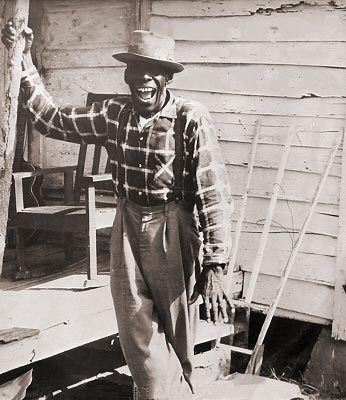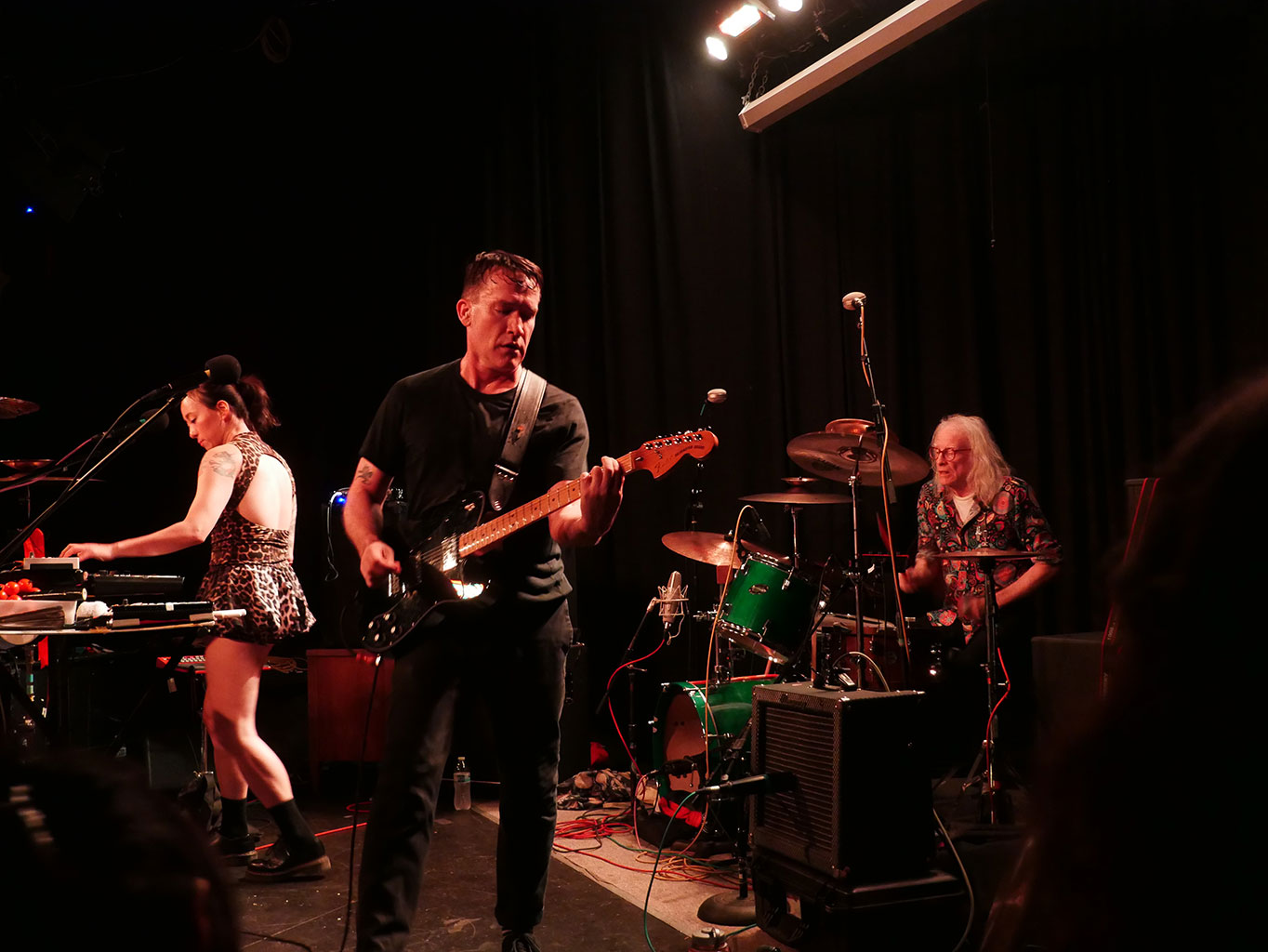Mississippi Joe Callicott (1899 – 1969)
 Callicott was not your typical North Mississippi blues musician. Musicians from the hill country tend to vamp on a few chords, focusing on a droning, almost hypnotic sound; Callicott was a fingerpicker in the vein of a Piedmont guitarist, with a dash of Jimmie Rodgers. He recorded three songs independently in 1929 and 1930: “Fare Thee Well Blues,” “Traveling Mama,” and “Mississippi Boll Weevil Blues”, the last of which went unreleased. Two additional tracks were recorded with Garfield Akers, the “Cottonfield Blues” — and here, his finger picking is energetic and nimble, bordering on aggressive.1
Callicott was not your typical North Mississippi blues musician. Musicians from the hill country tend to vamp on a few chords, focusing on a droning, almost hypnotic sound; Callicott was a fingerpicker in the vein of a Piedmont guitarist, with a dash of Jimmie Rodgers. He recorded three songs independently in 1929 and 1930: “Fare Thee Well Blues,” “Traveling Mama,” and “Mississippi Boll Weevil Blues”, the last of which went unreleased. Two additional tracks were recorded with Garfield Akers, the “Cottonfield Blues” — and here, his finger picking is energetic and nimble, bordering on aggressive.1
After the 1930 session, he went unrecorded for 37 years. He was not totally forgotten, however, as his songs started to appear in anthologies of Delta Blues. He was eventually found in Nesbit, Mississippi by George Mitchell, who recorded several songs with him in August 1967. These became the basis for a number of records and re-releases, the best of which was probably Fat Possum’s Ain’t a Gonna Lie to You. Unfortunately, his guitar playing had diminished somewhat by this time, but his voice had matured beautifully. His singing on “Frankie and Albert” is expressive and full of sadness yet was beautiful and nuanced throughout. After these sessions, he recorded several songs for Blue Horizons which were a bit lower-quality and rougher. He died in 1969 and was only recently given a proper headstone.
Purchase Mississippi Joe Callicott Albums On Amazon
Mississippi Joe Callicott – “Cottonfield Blues”
[audio:/wp-content/uploads/2013/04/Joe-Callicott_Cottonfield-Blues.mp3|titles=Mississippi Joe Callicott – Cottonfield Blues]Mississippi Joe Callicott – “Frankie And Albert”
[audio:/wp-content/uploads/2013/04/Joe-Callicott_Frankie-And-Albert.mp3|titles=Mississippi Joe Callicott – Frankie And Albert]
Fred Neil (1936 – 2001)
 Fred Neil was a fixture of the Greenwich Village folk scene and was regarded as a mentor figure by many of the more-famed musicians who came up during that time. He grew up in Florida and worked as a songwriter, which included tracks like “Come Back Baby” for Buddy Holly and “Candy Man” for Roy Orbison. He was an idiosyncratic figure, often frustratingly difficult to get to a gig or recording studio and suspicious of fame. But a number of famous musicians played with Neil, including Bob Dylan, David Crosby, John Sebastian and Stephen Stills.2
Fred Neil was a fixture of the Greenwich Village folk scene and was regarded as a mentor figure by many of the more-famed musicians who came up during that time. He grew up in Florida and worked as a songwriter, which included tracks like “Come Back Baby” for Buddy Holly and “Candy Man” for Roy Orbison. He was an idiosyncratic figure, often frustratingly difficult to get to a gig or recording studio and suspicious of fame. But a number of famous musicians played with Neil, including Bob Dylan, David Crosby, John Sebastian and Stephen Stills.2
Neil stuck to a six-string guitar and was best known for his bass voice. He recorded five studio albums that have been released, of which Fred Neil is regarded as the best. Fred Neil carries his most famous composition, “Everybody’s Talkin'” which was famously covered by Harry Nilsson for the movie Midnight Cowboy. “The Dolphins” is another famous song off of this album and reveals Neil’s interest in dolphins, to which he devoted nearly thirty years of his time. His 1965 classic, entitled Bleecker and MacDougal features another popular composition, “Blues on the Ceiling”. Friends of Neil’s have revealed that he recorded several more albums during the 1970s which have yet to be released.3 He stopped recording in the ’70s and his last gig was in 1981 in Coconut Grove, Florida.
Purchase Fred Neil Albums on Amazon
Fred Neil – “Candy Man”
[audio:/wp-content/uploads/2013/04/Fred-Neil_Candy-Man.mp3|titles=Fred Neil – Candy Man]Fred Neil – “Everybody’s Talkin'”
[audio:/wp-content/uploads/2013/04/Fred-Neil_Everybodys-Talkin.mp3|titles=Fred Neil – Everybody’s Talkin’]Fred Neil – “The Dolphins”
[audio:/wp-content/uploads/2013/04/Fred-Neil_The-Dolphins.mp3|titles=Fred Neil – The Dolphins]Bix Beiderbecke (1903 – 1931)
 Beiderbecke was a true rarity in the 1920s: a white and very successful Jazz musician who was held in high esteem by black musicians, many of whom were victims of discrimination. For that matter, he managed to create his own unique style of cornet playing, a considerable feat for any musician living in the shadow of Louis Armstrong. Legends surround Beiderbecke today, making it difficult to dispel myth from fact. He was born in Davenport, Iowa and musically interested from a young age. He apparently taught himself the cornet from listening to the Original Dixieland Jazz Band records and would sneak down to listen to bands playing on the riverboats, where he purportedly met Louis Armstrong.
Beiderbecke was a true rarity in the 1920s: a white and very successful Jazz musician who was held in high esteem by black musicians, many of whom were victims of discrimination. For that matter, he managed to create his own unique style of cornet playing, a considerable feat for any musician living in the shadow of Louis Armstrong. Legends surround Beiderbecke today, making it difficult to dispel myth from fact. He was born in Davenport, Iowa and musically interested from a young age. He apparently taught himself the cornet from listening to the Original Dixieland Jazz Band records and would sneak down to listen to bands playing on the riverboats, where he purportedly met Louis Armstrong.
Beiderbecke’s family was conservative but unable to rein him in, and he eventually ended up in Paul Whiteman’s orchestra. His playing was less bluesy and forceful than Armstrong’s, and many of his recordings come across as restrained and cool rather than hot. His most famous songs were “Singin’ the Blues,” recorded in 1927, and “Georgia On My Mind”, recorded just days before his death. Beiderbecke drank heavily and his health worsened over a few short years. In the 1970s, a sign of this alcoholism was found; an intern at NBC was going through the sheet music of the Paul Whiteman Orchestra and discovered a note written by the third trumpet at the solo, which said, “Wake up Bix”.4 After finally being kicked out of the Whiteman Orchestra in 1930, Beiderbecke died the following summer of lobar pneumonia, which was undoubtedly exacerbated by alcoholism. Years later, Miles Davis would interview people who had known Beiderbecke as he tried to capture his style.5
Purchase Bix Beiderbecke Albums on Amazon
Bix Biederbecke, Frank Trumbauer, and Jack Teagarden – “At The Jazz Ball”
[audio:/wp-content/uploads/2013/04/Bix-Beiderbecke_At-The-Jazz-Band-Ball.mp3|titles=Bix Biederbecke, Frank Trumbauer, and Jack Teagarden – At The Jazz Ball]Frank Trumbauer & His Orchestra Featuring Bix Biederbecke – “Singin’ The Blues”
[audio:/wp-content/uploads/2013/04/Bix-Beiderbecke_Singin-The-Blues.mp3|titles=Frank Trumbauer And His Orchestra Featuring Bix Biederbecke – “Singin’ The Blues]Oscar Aleman (1909 – 1980)
 Oscar Aleman has recently bounced back into the mainstream after one of his songs was used in the Woody Allen film Midnight in Paris; nevertheless, he remains sorely underappreciated. Born in Argentina, he began playing music at an early age and went to Europe in 1929. He was hired by Josephine Baker to play in her band in Paris and spent the next several years in France. During this time, he befriended the gypsy jazz guitarist Django Reinhardt. The two were so closely associated that Aleman often served as a backup whenever Django couldn’t be found by his bandmates, which apparently was a frequent occurrence. Tragically, despite their friendship, the two never recorded together. Aleman returned to Argentina during WWII and spent the remainder of his life there.
Oscar Aleman has recently bounced back into the mainstream after one of his songs was used in the Woody Allen film Midnight in Paris; nevertheless, he remains sorely underappreciated. Born in Argentina, he began playing music at an early age and went to Europe in 1929. He was hired by Josephine Baker to play in her band in Paris and spent the next several years in France. During this time, he befriended the gypsy jazz guitarist Django Reinhardt. The two were so closely associated that Aleman often served as a backup whenever Django couldn’t be found by his bandmates, which apparently was a frequent occurrence. Tragically, despite their friendship, the two never recorded together. Aleman returned to Argentina during WWII and spent the remainder of his life there.
Aleman gets compared to Reinhardt frequently, but aside from their shared technical proficiency, the two were very different musicians. Aleman played in a wide variety of styles and brought a great many Latin techniques and styles into the recording studio. Even his South American influences were diverse, though, as his recordings included a Brazilian-influenced album of standards. He recorded prolifically, though American listeners may find it difficult to find hard copies of his music. A number of overlapping compilations are available, the best of which is Swing Guitar Masterpieces, 1938-1957. For starting tracks, I would suggest “Russian Lullaby”, “Darktown Strutters Ball”, and “Improvisaciones Sobre Boogie Woogie”.6
Purchase Oscar Aleman Albums on Amazon
Oscar Aleman – “Darktown Strutters Ball”
[audio:/wp-content/uploads/2013/04/Oscar-Aleman_Darktown-Strutters-Ball.mp3|titles=Oscar Aleman – Darktown Strutters Ball]Oscar Aleman – “Russian Lullaby”
[audio:/wp-content/uploads/2013/04/Oscar-Aleman_Russian-Lullaby.mp3|titles=Oscar Aleman – Russian Lullaby]Oscar Aleman – “Improvisaciones Sobre Boogie Woogie”
[audio:/wp-content/uploads/2013/04/Oscar-Aleman_Improvisaciones-Sobre-Boogie-Woogie.mp3|titles=Oscar Aleman – Improvisaciones Sobre Boogie Woogie]Karen Dalton (1937 – 1993)
 Everybody seems to agree that Karen Dalton was a “white Billie Holiday”, as I’ve seen on several forums and blogs. I hesitate to compare artists too much as I think it runs the risk of cheapening what makes one unique, but with these two, there are some apt comparisons to be made. Both had powerful voices with a relatively narrow range and a lot of expressiveness. Both also led hard lives marred by alcoholism and personal misfortunes. Karen Dalton was born in Enid, Oklahoma and had already been married twice by 21. She became part of the burgeoning Greenwich Village Folk Scene and spent time between New York and Colorado. Two albums were recorded before she faded into obscurity — one in 1969 and one in 1971. She died in 1993 from complications with AIDS.
Everybody seems to agree that Karen Dalton was a “white Billie Holiday”, as I’ve seen on several forums and blogs. I hesitate to compare artists too much as I think it runs the risk of cheapening what makes one unique, but with these two, there are some apt comparisons to be made. Both had powerful voices with a relatively narrow range and a lot of expressiveness. Both also led hard lives marred by alcoholism and personal misfortunes. Karen Dalton was born in Enid, Oklahoma and had already been married twice by 21. She became part of the burgeoning Greenwich Village Folk Scene and spent time between New York and Colorado. Two albums were recorded before she faded into obscurity — one in 1969 and one in 1971. She died in 1993 from complications with AIDS.
Dalton has begun to enjoy a revival in recent years as previously unreleased fan-recordings and live concerts have made their way into the hands of record companies. The album I recommend to start out with isn’t one of her studio albums but Cotton Eyed Joe, a live album from 1962. She alternated between banjo and the twelve-string guitar while she sang, and this particular recording showcases this.7 The sound quality is also remarkably good, though not too good; at any given moment, you can tell she’s playing in a small folk club, which, for me, enhances the experience. Start with “It Hurts Me Too”, for her version has become the definitive one for that standard. “One May Morning” is another beautiful track that deserves your attention.
Purchase Karen Dalton Albums on Amazon
Karen Dalton – “It Hurts Me Too”
[audio:/wp-content/uploads/2013/04/Karen-Dalton_It-Hurts-Me-Too.mp3|titles=Karen Dalton – It Hurts Me Too]Karen Dalton – “One May Morning”
[audio:/wp-content/uploads/2013/04/Karen-Dalton_One-May-Morning.mp3|titles=Karen Dalton – One May Morning]References
1 Mississippi Joe Callicott Mississippi Blues Trail.
2 Fred Neil: The Other Side Of Greenwich Village 60’s Folk Scene, Perfect Sound Forever.
3 Ric O’Barry, Fred Neil.
4 Wake Up Bix, mlkshk.
5 Bix Beiderbecke played with lyric beauty and had a different influence than Louis Armstrong., Jazz-Music-History.
6 Oscar Alemán: El Increible Swing, Classic Jazz Guitar.
7 In Her Own Time: The return of Karen Dalton, Austin Chronicle.
Ω







Fantastic! Thank you.